Wednesday Afternoon
April 1, 2015
Paynes Prairie State Park
Micanopy, Florida
We leave the Devil’s Millhopper, our morning excursion. If you missed it, it was really lovely and you can see it here.
We continue on down the road, cross under I-75 and in a total of 13 miles, on increasingly rural roads, arrive at Dudley Farm Historic State Park. We are really getting our education today. First the only Geologic State Park and now an historic one.
Dudley Farm has been recommended to us by many of my blog commenters. They say we will like it because it is a 19th century farm which is pretty much how we lived the farm part of our lives until jumping into the 21st century and starting to RV Fulltime.
First thing we do is take advantage of their picnic area between the parking lot and the Information Building. I was positive David took a picture of me eating my lunch and watching the bluebirds but I sure can’t find it. But I do have pictures of the fence post bluebirds and the view from the table. The bluebirds really do make us feel at home because we had a 15 house bluebird trail on the farm. We didn’t put them on fence posts though because black snakes like to raid their nests. But we put them near fences as they have done here so that the little ones would have something close by to fledge to.
This is mom she’s on one of the posts. We watch her while we eat. Sure is a beautiful day.
First stop after lunch is the Information Building which is a perfect period house built by Peter Garfield and Cordia Thomas Hodge in 1918 and moved from West Newberry, Florida in 1998.
Inside are supposed to be Guides for a Self Guided Tour but we look all over and find none. We do find vintage pictures of the farm, information about the Dudley Family, family artifacts and pictures of Miss Myrtle Dudley who in 1983 donated 24 acres of the original farmstead, all its buildings and furnishings to the State of Florida. She said she was carrying out the wishes of her mother who asked her to make sure the farm remained in tact.
Since there were 12 children and thus many many grandchildren I guess none of them wanted to keep it or could afford to. I find that sad. I’m not sure this is what her mother had in mind but at least it wasn’t all torn down and turned into a subdivision.
But after looking at some of the pictures, it is clear that the place was allowed to deteriorate terribly so it would have taken a lot of time and effort or an even greater amount of money to restore it.
This picture is of the farm in 1915. It looks pretty much the same now.
Sorry for the window glare. No way to avoid it.
Next door to the Information Building is a Store and beyond that are carriage buildings. When we discover the park closes at 5:00 and the farm itself at 4, we cut our time in the Information Center short and will see the other buildings after 4:00. It is already 2:00 and there is a lot to see.
I love the way they have preserved the atmosphere of the farm by having the parking lot and these buildings up near the main road and not near the farmstead buildings. You can see this clearly on the map of the grounds above.
We take a nice path to what was the original Gainesville Road. The house stands at the crossroad of the original Gainesville Road running East to West and the north south road leading to Archer and Jonesville. The roads are still dirt and look much like they did 150 years ago when horses, mules, wagons and foot travel were the main methods of travel. I feel like I am back in another time.
In 1859, Philip Benjamin Harvey Dudley (PBH Sr) purchased, with a land grant, the first 300 acres of what would grow to be a 640 acre farm with 18 buildings. He and his wife Mary Magdelina Thompson had 7 children. Of the five of these who lived to adulthood only one was a boy, PBH, Jr., who was seven when his father purchased the land and moved them from south Carolina to Florida.
PBH, Jr went on to develop the farm and by the 1880’s it was an important center of the community. It provided a store, post office, cane syrup making complex and cattle dipping vat. Three generations of Dudley’s worked the cattle, crop and vegetable farm through the decades.
The PBH Dudley Jr family was 8 girls and 4 boys. The youngest of these was Myrtle who, when all of her siblings were deceased, donated the farm to the State of Florida.
Mostly the house was full of bedrooms upstairs and down as you can imagine with that many people. The kitchen and dining room are in a separate building behind the house. Wood cooking stoves created a fear of fire. I am amazed that Miss Myrtle lived here all her life without changing much of anything. Either that or the state “renovations” changed it back. Unfortunately for us there are no docents or volunteers or rangers although the information says it is a working farm.
Later, outside we do see two men working on repairing something.
Rope beds and quilts remind me of our farm. We slept with both for years. My Great Aunt Carrie always told me that to be a quilt, the top had to be quilted. Otherwise, if it was just tacked, like a couple of the ones below, it was a comforter and should be filled with heavier batting. Often old woolen blankets or even clothing were sewn into batting for comforters. Both quilts and comforters have pieced tops.
If you can crochet, you can make rag throw rugs from old clothing. These folks really didn’t throw much away. What couldn’t be used for quilts or comforters was torn into strips and made into rugs. There was a small basket of rug strips nearby, certainly not enough to make a rug this size. It takes a lot of long strips to crochet into a rug.
Other things of interest that caught my eye were the linen shelves, the galvanized “bath tub” and the dresses that look just like what my Aunt Carrie wore with a covered belt. The dress actually wraps around a bit and snaps way further over on the side. Must have been a popular pattern.
We walk through the “dog trot” middle hallway which cooled the house and out the back door, Outside we find a corn husk broom. I’d like to try one of these. I haven’t been able to find a seriously decent broom anywhere. I suppose it would have the same problem with pieces breaking off that the straw ones do.
Notice the foundation of the house. This is pretty much what our farm house sits on but not as fancy. Big rocks in our case.
Indoor plumbing wasn’t added to the house until the 1950’s and if it is here now it must be upstairs where we weren’t permitted. Until then the three-seater outhouse was used. Did multiple people really use these things at the same time?
David admires the cistern set up for collecting rainwater off one end of the porch roof.
As promised, right behind the house is the kitchen/ dining room.
Looks like they have a kettle in the fireplace. The doors were locked so you could only peer in. That’s one dandy looking cook stove. I wonder if Myrtle cooked her meals here in the 1970’s. Sure wish there was a docent to ask.
To the right of the house and kitchen is the laundry and canning area. I’m sure the canning was done on the stove but the results are stored here. Notice the line of washtubs. David gave me a demonstration of how this works. He says he went with his mother in Oklahoma as a toddler when she did the laundry. He doesn’t think his older brother Roger ever saw this since he was probably 11 or so at the time. What about that Roger?
We had a tall floor churn and a glass one like the one on the top shelf which we used with the rich cream from our raw milk to turn into fabulous butter. The cans on the shelves look just like ours. All during the late summer and fall we were putting up one thing or another. Our food has never tasted quite as good as it did then.
This opera star Don Juan is constantly gobbling while we are in the wash house so we follow the noise and he shows off for us.
Look at these colors. Both his feathers and his face. We never had domestic turkeys but we saw the hens from a flock of wild ones often. I don’t remember the tom being quite this flashy looking. Although obviously I couldn’t get this close to them for study and pictures.
His girls don’t seem to be paying much attention at all to him.
I really can’t figure out why he needs to be quite so ornate. How could natural selection have favored this design?
He’s definitely a real show. I had to lighten this picture for you to see the intricate feathers.
Enough talking turkey. How about them mules? Now these are sweet animals. We adopted a pair of wild burros from Death Valley and they were not inclined to be ridden or to pull farm machinery which these mules do with no problem.
So what’s the difference between a mule and burro? A mule is the offspring of a donkey or a burro and a mare horse. “Technically” a burro is descended from the Spanish donkeys brought to the “new world” in the 1500’s while a donkey is the name used for those introduced directly from Europe. I’m not sure these blood lines are so pure but I do know that because of the chromosome difference between horses (64) and donkeys (62) a mule is nearly always sterile.
For sure these mules are bigger and stockier than our burros. One is in the pasture, the other in the barn.
We recognize the Rhode Island red chickens. We raised those and Buff Orpingtons. The Dudleys had Reds and Plymouth Rocks, the black and white breed. Not sure why this trio was in a pen of their own near the turkeys while the larger flock was on the other side of the area near the mule barns, until I see that there are two roosters. That makes for serious fights often to the death. If you allow your hens to breed and set the eggs you have to figure out what to do with all the males once they are beyond the chicks stage.
I’m amazed at such a pristine chicken house floor. Looks like the ladder to the roost for these gals is missing some rungs.
Rhode Island Red Rooster and his Plymouth Rock girls
View of the back of the house with the kitchen on the left and the well on the right.
This hand pump provides water to the open line for the animal drinking trough. Still works, still used. Didn’t need priming.
The last building of real interest is the Dudley Store. There were tool sheds, equipment barns and all those things guys like that bring out my impatience. I have some pictures of those for David but you have to cut somewhere in a too long post. Right? Sorry guys.
Post office on the left. Stove and checkers for jawing in the middle and store goods on the right and back walls.
Two of my favorite things are the ledger on the counter right and the high button shoes below it and to the left.
In 1901 Mr. Dudley had some nice penmanship and it was interesting to see the prices and what was purchased. Click the picture if you can’t read it. 1 soup bone $.25. The most expensive things were “rent” $4.00 and School Books $6. 26.
After the store we walk around the back of the barn to see the other mule. By the time we get there, they are both there and come right up to the fence for some ear and chin rubs.
I think it’s me they want to see but then we discover that one of the working farm people is here to feed them and they know the drill. They are amusing themselves with me while he gets their feed from the building just to my left.
This is a seriously self sufficient farm. Not only animals but they grow vegetables and fruits. We’ve seen fig trees all over the place and orange trees with oranges on them. David tried one from under the tree on the ground and pronounced them much better than wild oranges. HA!
The vegetables are in the kitchen garden. I assume they also have fields of crops as well. Not too much growing yet but the ground is prepared. We see onions, two nice rows of potatoes and what look like beans coming up. They have frost conditions here in northern Florida so I’m sure they time their crops as we did. David gives their wheeled tools a try for old times sake. These things are way better than hand tools for nearly everything. Sure wish we could have used them in our rock hard red clay. They work great in this sandy soil.
We end up our guideless self guided tour with what we know is the sugar cane processing area. It really is a good thing we’ve “been there and done that” or we wouldn’t have known a lot of this without information of some sort. Sure hope they have it for other visitors.
There are two vats for boiling down the cane after was it is broken down by the sugar cane press. One of the vats has a mesh tray of green onions drying over it. The fire is at the near end, the smoke stack at the rear.
This is a ‘sort of’ picture of the press since I cut out the harness for the mule from the right hand end. He walks around and around while someone feeds the cane stalks into the press and the juice is collected for boiling.
Time to leave what would be called “the old Dudley place” in our neck of the woods. Our farm has always been named Greenfield Mountain Farm but locally it has equally always been referred to as “the old Dickerson place”. Mr. Dickerson died in the late 50’s.
Out on the Old Gainesville road we find one of the biggest of many big trees on the property.
The farmsted has closed and the workers are off duty. Looks like it’s back to the future for this guy. Love his outfit.
Other barns and outbuildings are on this end of the property and so is the windmill. I wonder how the windmill could have been used by the house or buildings so far down the road. Perhaps it was moved during the restoration. Another question for the ranger/docent who isn’t around.
From the windmill we walk over to go into the Commissary building. Funny name for it here I think. Having been married to a man in the military at one point in my life, I always think of that word as associated with them. Farm Store seems more appropriate here.
The sun is low in the sky and directly behind the building so I’m not able to get a good distant shot of it and its porch.
The information center hasn’t closed before 5:00 but the Commissary has unfortunately. I wanted to see what they are selling from the farm at this time of year. But it is not to be. They have a blackboard by the door with a list of some things.
There he is again right on the steps of the commissary.
Are you following me around with that flashy dewlap?
Didn’t I see you just yesterday at the La Chua hike?
Well no he isn’t following me and he isn’t related to the Geico gecko. The gecko is in Florida and though he’s so common he’s often called the house lizard, he’s non native and brown. There is a non native green gecko but only in the Keys. This guy looks a lot like the gecko but he’s a native Florida green anole. He’s often called a chameleon but he isn’t one. He can only change colors to gray or brown. This display is, of course, a warning to other males and an attempt to attract females. He is very funny to watch as he does three head bob like pushups to show how strong he is before his display. Nice job there.
Now stop following me!
Back to the state park. My advice is to come on a Wednesday morning, not in the afternoon as we did. You might be more likely to see the farm workers who can answer questions, and maybe you can actually get a guided brochure. Plus you’ll get to observe hand crafts such as these being done the old fashioned way like this lovely wheat weaving that was hanging on the door. Of course there are no doubt more staff on the week-end if you are brave.
It is a short drive back home for dinner. We close off our day by biking down to the boat ramp for sunset. The armadillos are out but they aren’t interested in the sun. These two are really scurrying all around the edges of the parking lot. I’ve never seen armadillos move that fast. They seriously didn’t stay still long enough to take pictures of them that, in the low light, aren’t blurry.
The sunset over Lake Wauberg of course did not disappoint.
THE END



































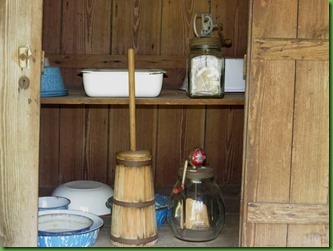



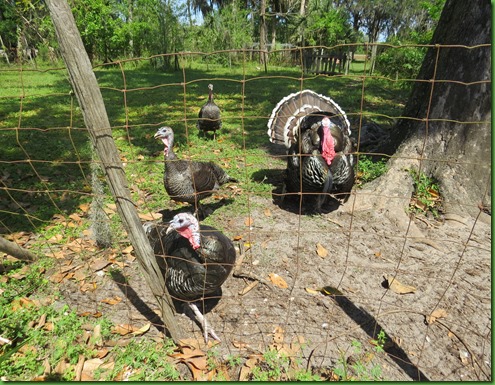








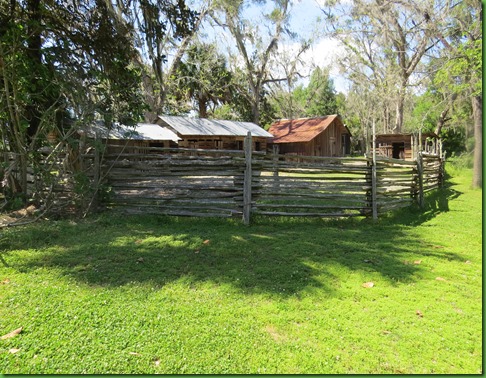





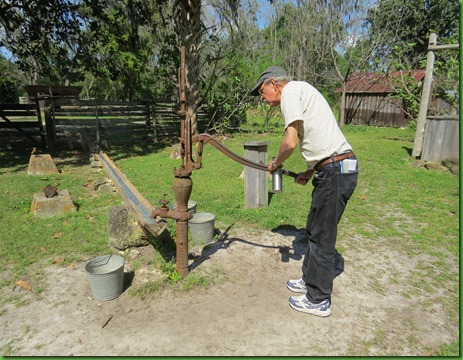




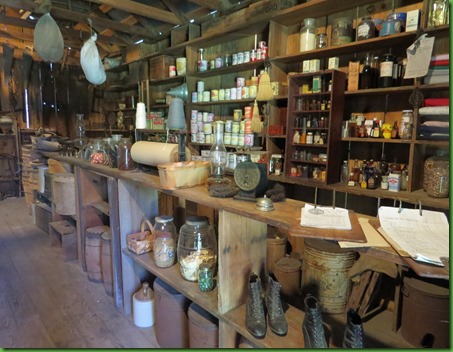


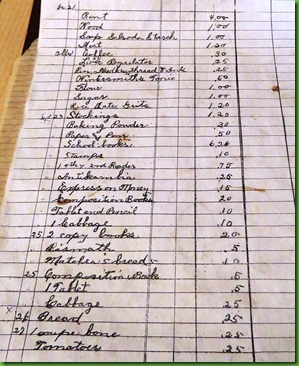






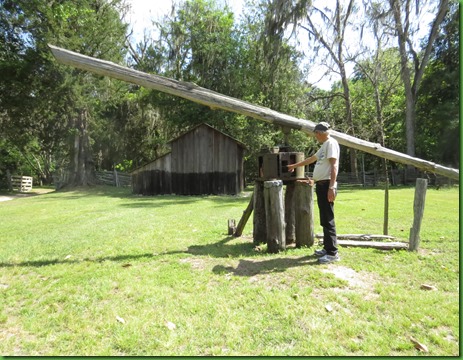





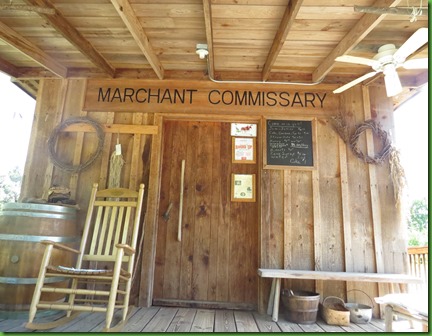






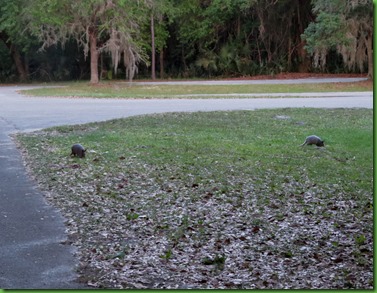

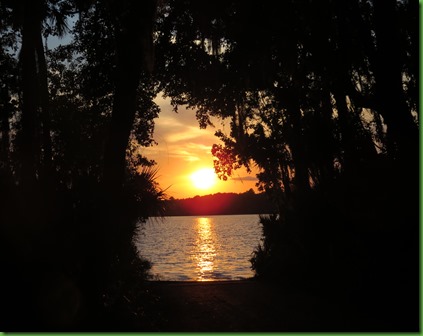


Enjoyed the post, reminds me of childhood. We used a mule drawn sugar cane press just like that. Our oven and vat was different though. Great sunset, a real keeper. Thanks for the tour
ReplyDeleteSherry, I live in Florida and haven't seen or even heard of many of the cool places you and David have been here. Love all your photos and information on everything. Thanks for your great blog.
ReplyDeleteI may have been born in the wrong era but was raised as a suburbanite with occasional farm visits. This is a marvelous farm that's been well restored. Your narrative is so familiar you could be the docent.
ReplyDeleteFunny to see the "worker" in full costume...talking on his cell phone. That turkey was really neat. It all made me miss our sticks and bricks and chicks, etc.
ReplyDeleteThat was a really nice place to see!! There was lots of 'stuff' in the house and buildings wasn't there, just like the people walked off and left everything.
ReplyDeleteMale turkeys are surely wonders of nature with all the colors and textures.
Very interesting post... Nice that so much was familiar to you and you were able to share it with us. Without someone to explain things, we just couldn't really understand how it all works. Speaking of work...that is a LOT of work!!! Can't even imagine how they did all that they did. Thanks for the great tour!!!
ReplyDeleteGreat tour Sherry. I love seeing old houses and farms. It always amazes me how clutter free their homes were....no knickknacks or useless stuff.
ReplyDeleteBaxter would sure have liked one of those turkey tail feathers. He absolutely goes nuts with them.
I didn't know you were in the service? What branch?
Not sure a docent could have made a huge difference for you - and we have you, so we're good! While this farm was wonderful to tour, I loved seeing a lot of what your life was like pre-RV. It is not surprising given your connection to the earth and the seasons, that your farm life was "simple". I've wondered too why Mr. Turkey is so brightly colored in a natural environment that makes him easy to spot. One species whose domestication probably saved it from extinction :-) Love all the quilts - so many stories sewn into those big warm hugs. New ones are beautiful, but lack the power of those made with scraps from a real life. I'm glad Myrtle found a way to grant her mother's wish, and that you shared it with us :-))
ReplyDeleteCan't imagine living back then and all the hard work that had to be done to keep a farm running. Maybe things would be much better if there was such hard work to do! Didn't know the difference between donkey/mule/burro, thanks for explaining!
ReplyDeleteThe turkeys, chickens, and mule are real characters!
ReplyDeleteThis reminded me of the place my mother's family moved into when they came down from the Blue Ridge Mountains. My great aunt and uncle lived there when I was little, so I got to enjoy it. No store or sugar cane, of course, but chickens to feed, cows to milk, fresh churned butter and a two-seater outhouse. It was idyllic in so many ways. Thanks so much for sharing. Love the sunset pictures.
ReplyDeleteIts interesting that you are able to draw parallels between Dudley Farm and your real life farm. There must have have been no privacy at that time, what with three holes to do your business with other people.
ReplyDeleteI can't watch closely the Turkeys head, it makes me shiver instead of attracted despite its color.
Wonderful combination of natural wonders and lessons from human history. The work was hard and never ending so no wonder this way of life is no longer evident except in museums. It is romantic to think it was a better time, but in many ways it was.
ReplyDeleteAlmost a clone of your farm! I hope it didn't make you homesick. Amazing that so much that is on display is exactly like how you ran your farm. I'd have been lost, being a city boy... ;c)
ReplyDeleteI'm glad you got to visit Dudley Farm! So interesting to know that there are so many similarities to your farm life pre-RV'ing. Great tour and photos, Sherry. I felt like we were there again. :-)
ReplyDeleteI really enjoy places like this, especially when fully equipped. A living history farm:) "Don Juan" is adorable! He has quite a harem there! What a fun time!
ReplyDeleteSherry, I saw the kayak/bike rack in one of the MH magazines last year. It was new and if I remember correctly, the photo had long kayaks in it. If I see it again, I'll let you know.
Great tour, another SP I did not know about:(
ReplyDeleteThat was quite an extensive farm you were able to visit, though it is too bad the docents were missing!
ReplyDeleteI did not know there were armadillos in FL. We were so excited to finally see these creatures in TX, I just love them! They are much, much faster than I ever expected them to be!
What an interesting place to visit, looks like you had a good time. When our boys were in kindergarten one of the things they did every year was build bluebird houses. Over the years we enjoyed watching many bluebirds.
ReplyDeleteThat cellar with the cans really reminded me of the one at the Farm. I liked your tour! Neat to see the animals, especially the Rhode Island Reds-how was the coup so clean?! Nicely kept buildings. 12 people used that outhouse...? I will say no one ever romansizes that part of the past-lol :)
ReplyDeleteWe always got an assortment of chicks in the mail every spring when we had the farm. It was my favorite thing about those 6 years!
ReplyDeleteHello! First, I would like to thank you for such a wonderful blog of our delightful State Park, and for stopping by to visit us! Next, I would like to apologize, we are very sorry, for not having our standard self-guided brochure's available for your use! Unfortunately we were waiting for them to be funded, and printed around your visit time.
ReplyDeleteI do want to let you know that Ms. Myrtle did modernize during her life time. The house itself had a 1950's kitchen/dining room, and a bathroom added to the back end were the porch is at this time. You are correct in stating that the park did bring some the structures back to the 1880's 'look'.
Again, thank you for taking the time to visit us. Maybe you can visit us during one of our larger yearly events. We have a lot of docent volunteers interpreting the farmstead during those days.
Sandra Cashes, Park Services Specialist
Love your blog story to the park, would so love to go. Would you mind a link to your blog story and could i use your photo of the three seater outhouse for my blog post. I'll give you credit for photo and link back to your blog.
ReplyDeleteJeanne